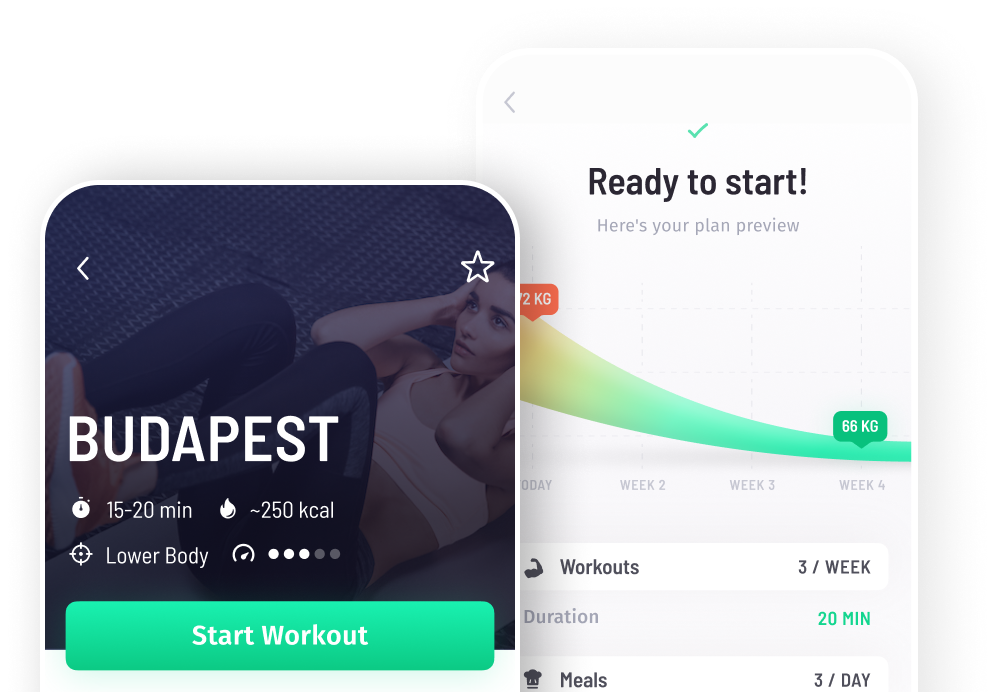You have surely heard the terms ‘aerobic’ and ‘anaerobic’ amongst people describing different types of exercise, and you may be wondering ‘what is the difference between aerobic and anaerobic exercise?’
In order to properly incorporate both types of exercise into your fitness regime and to know how your body produces energy during exercise, it is crucial to understand the difference between aerobic and anaerobic exercise.
Let’s go on to learn about aerobic and anaerobic exercise, including the definition and examples of each.
Aerobic and anaerobic exercise definitions
Aerobic exercise
Your main energy source during aerobic workouts is oxygen. With oxygen, your body is able to primarily burn carbohydrates and fat.
Aerobic exercise is also known as ‘cardio’. It is performed at low to high intensity and it stimulates the heart rate and breathing rate to where it can be sustained for the duration of an exercise.
During aerobic exercise, you’re working up a sweat, breathing hard, and blood is pumping through your body to bring oxygen to your muscles for an extended period of time.
Aerobic exercise is simple and a way to tune into your body and discover how it performs and feels during workouts and movement. It also reduces your resting heart rate, strengthens your heart, and improves your stamina.
If new to exercise or a fitness regime in general, it is best to start with aerobic training and work your way up to anaerobic exercise.
Anaerobic exercise

Anaerobic exercise does not use oxygen as an energy source, and it instead breaks down carbohydrates from blood glucose or stored glucose for energy.
Anaerobic exercise is a powerful workout that requires a lot more “work” and pushes your body. It involves quick bursts of energy for a short time, anywhere from 30 seconds to a few minutes, and it is performed at maximum effort. With this type of exercise, you will be out of breath in just a few moments.
When you first start out with aerobic exercise, you actually start using anaerobic energy because it is ‘quick’ energy, then you shift to aerobic energy.
Anaerobic exercise is intense enough to cause lactate to form and build muscle mass. It promotes strength, speed, endurance and power.
Other benefits of anaerobic exercise include: a metabolism boost, increased fat loss and better ability to maintain weight, increased bone density, reduced risk of disease, better protection of joints, and boost in energy and mood.
The meaning of aerobic translates to “with oxygen” and anaerobic translates to “without oxygen”. This is a quick and easy way to remember the difference between the two!
Aerobic and anaerobic exercise examples
Aerobic exercise examples:
- Swimming laps
- Jogging
- Power-walking
- Endurance cycling
- Dancing
- Hiking
- Cross-country skiing
Anaerobic exercise examples:
- Jumping rope
- Tabata training
- Plyometric training: Plyometric exercises involve jumping or explosive movement.
For example, jump squats are an effective plyometric (and anaerobic) exercise.
Here’s how to do a proper jump squat:
- Begin by standing upright with feet wider than shoulder width apart and toes pointed outwards.
- Bend at your both your knees and hips, while maintaining a flat back and squeezing your butt and abs.
- Keeping your knees in line over your 2nd toes, continue to lower yourself without pulling on your neck with your arms until your thighs are parallel to the ground.
- Extend your knees and explode into the air, reaching your arms up.
- Land and come back to squatting position.
- Sprinting
- Biking
- Weight lifting
- Interval training
- High-intensity interval training (HIIT): HIIT training are short but intense workouts that you can do at a gym, at home, or really anywhere. Here is an example of a HIIT workout that is a great way to get effective anaerobic exercise in.
Cardio HIIT Workout
Workout Time: 16-29 minutes Equipment Needed: None (Yoga Mat Recommended)
How To:
- Start with the tailored warm-up and then move through the exercises, with short rests in between.
- Begin the workout and do it as intensely as you can. The idea is to keep your heart rate elevated.
Tailored Warm-Up:
- Plank Jacks: 30 seconds
- Cross Body Crunches: 1 minute
- Lying Leg Rotations: 1 minute
- Plank Jacks: 30 seconds
- Cross Body Crunches: 1 minute
- Lying Leg Rotations: 1 minute
Cardio HIIT Circuit:
- Swinging High Kicks: 40X (20 per leg)
Rest: 20 seconds
- Squat Reaches: 24X (12 per arm)
Rest: 20 seconds
- Bent Knee Leg Raises: 15X
Rest: 20 seconds
- One Arm Plank With Rotations: 30X (15 per side)
Rest: 20 seconds
- Side Plank: 1’ 20” (40” per side)
Rest: 20 seconds
- Superman Raises: 15X
Rest: 20 seconds
Repeat 2 more times. Complete the circuit a total of 3 times.
Cool down and stretch.
As we can see, there is a place for both aerobic and anaerobic exercise in your fitness regime.
Did you enjoy this article? Share it!
Related Articles
You don't need an expensive membership to a fancy gym to get your cardio exercise done. There is a wide variety of fun cardio workouts that…
When starting any type of exercise, there is always some risk associated. Whether this risk be pulling a muscle that you haven’t used for a…
What is the afterburn effect? How does it occur? Check out everything that you need to know about this term.

